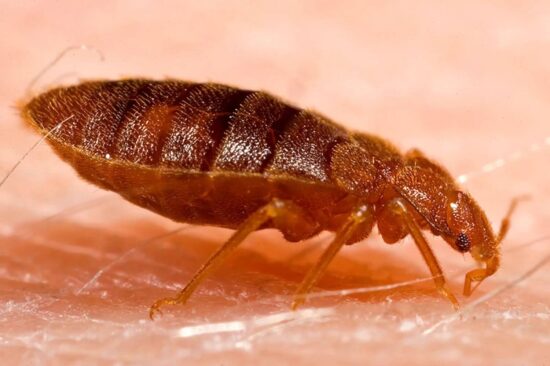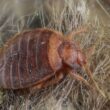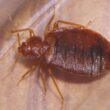Picture this: you wake up with mysterious red bites on your arms, and suddenly you’re convinced bed bugs are flying around your bedroom at night. The thought of blood-sucking insects soaring through the air is enough to keep anyone awake. But here’s some good news that might help you sleep better tonight.
Bed bugs cannot fly. Not even a little bit. This fact is backed by solid science, and understanding how these pests actually move around is the key to preventing and controlling them effectively.
The Simple Answer: Bed Bugs Don’t Have Wings That Work
Let’s get straight to the point. Bed bugs lack wings and therefore cannot fly, according to Stephen Kells, a bed bug researcher at the University of Minnesota. This isn’t just one person’s opinion. It’s a scientific fact supported by entomologists everywhere.
Bed bugs are classified as “true bugs” with characteristics that include “wings that are not used for flying”. Even though people often ask “can bed bugs fly,” the answer has always been the same throughout history. These pests have never had the ability to take to the air.
The confusion about whether bed bugs can fly often comes from seeing other small insects in bedrooms. But if you spot something flying around your room, you can be sure it’s not a bed bug.
- Kill bed bugs and bed bug eggs
- Use spray as a spot treatment around bed frames, mattress seams/tufts/folds, and baseboards
- Kills even the toughest bed bugs
- The continuous spray Comfort Wand easily gets into hard-to-reach areas
What Bed Bugs Actually Look Like
Adult bed bugs are about the size of an apple seed and have flat, oval bodies that are reddish-brown in color. They have small wing pads that are only vestigial wings, meaning their wings do not fully develop and they never gain the ability to fly.
These wing pads are basically leftover parts from their evolutionary past. The vestigial wing pads emerge during the transition from the 5th instar nymph stage to adulthood, but they cannot use them for flight. Think of them like the tiny leg bones some whales have. They’re there, but they don’t work.
Young bed bugs, called nymphs, don’t even have these wing pads. They’re smaller than adults and look translucent or whitish-yellow until they’ve had a blood meal.
How Bed Bugs Actually Get Around
Since bed bugs can’t fly, how do they move from place to place? The answer is pretty simple: they crawl. Bed bugs crawl at about one meter per minute, which is roughly the speed of an ant.
An adult bed bug can cover four feet in one minute using six legs that have claws for gripping rough surfaces. However, these insects lack suction pads, making it difficult for them to climb smooth surfaces.
Bed bugs also can’t jump like fleas. They do not have powerful back legs that can propel them long distances. Their movement is limited to crawling, which is actually good news for homeowners trying to control them.
Why People Think Bed Bugs Can Fly
The question “can bed bugs fly” comes up so often because people confuse them with other insects. Many small, brownish insects can be found in bedrooms, and some of them actually can fly. Carpet beetles are often confused with bed bugs but can fly and have a shell that looks like a ladybug.
There’s also a lot of bad information online about bed bugs. Some websites spread false claims without backing them up with science. When people find bugs in their beds, they sometimes imagine the worst-case scenario. The idea of flying bed bugs is scarier than crawling ones, so the myth keeps going.
Bed bugs can move surprisingly fast when they want to. This quick crawling motion might make people think they’re jumping or flying. Here’s a fun fact: Bed bugs can only “fly” if you put a blow dryer behind them, and then they’ll fly about 1.2 meters. But that’s just the air pushing them around, not actual flight.
Bugs That Look Like Bed Bugs But Can Actually Fly
Several insects get mistaken for bed bugs, and some of these can fly. Carpet beetles are smaller than bed bugs and often have speckled patterns of white, yellow, brown, and orange on their bodies. They have wings and can fly to new locations, and adults are attracted to windows and areas of light. Unlike bed bugs, carpet beetles don’t bite people. They eat fabric instead of blood.
Spider beetles look similar to engorged bed bugs but have longer legs and a more bulbous shape. They can fly and are often found in pantries and storage areas. Booklice are tiny insects that have wings and bigger heads compared to bed bugs. They prefer humid environments and feed on mold and fungi.
If you see small flying insects in your bedroom, they’re definitely not bed bugs. This can actually be a relief, since bed bugs are much harder to get rid of than most other household pests.
- Kill bed bugs and bed bug eggs
- Use spray as a spot treatment around bed frames, mattress seams/tufts/folds, and baseboards
- Kills even the toughest bed bugs
- The continuous spray Comfort Wand easily gets into hard-to-reach areas
How Bed Bugs Really Spread Without Flying
Even though bed bugs can’t fly, they’re still excellent at spreading from place to place. Because no life stages can fly, bed bugs rely on passive transportation by their host to spread.
They can hitch a ride in luggage, purses, backpacks, or other items placed on soft or upholstered surfaces. This is why hotels are common sources of bed bug infestations. Bed bugs love to hide in the seams and cracks of furniture. When people buy used mattresses, couches, or chairs, they might unknowingly bring bed bugs home.
Bed bugs can move within walls, through floor and ceiling openings, and on pipes. They’re surprisingly good at finding small cracks and crevices to crawl through. When bed bugs are on walls or ceilings and they detect body heat or carbon dioxide from a sleeping person, they might drop down onto the bed. This isn’t flying, just gravity doing its job.
Why Bed Bugs Not Flying Is Actually Good News
The fact that bed bugs can’t fly makes them easier to control than you might think. Since bed bugs can only crawl, they spread more slowly than flying insects. This gives homeowners more time to notice an infestation and take action.
Bed bug traps and interceptors are particularly effective because they take advantage of the fact that bed bugs are unable to climb smooth surfaces. These devices trap bed bugs when they try to crawl up bed legs. Pest control professionals can focus their treatments on specific areas where bed bugs crawl, rather than having to worry about aerial spraying.
Knowing that bed bugs hitchhike rather than fly helps people take the right precautions when traveling or buying used furniture.
Smart Prevention Tips Based on How Bed Bugs Actually Move
Since you now know the answer to “can bed bugs fly” is definitely no, here are some practical prevention tips. When staying in hotels, keep luggage in the bathroom while you inspect the room. Check the mattress seams, headboard, and upholstered furniture for signs of bed bugs before settling in.
Before bringing any used furniture into your home, check it carefully. Look for dark spots, shed skins, or live bugs in seams and crevices. Bed bug-proof mattress covers can prevent bugs from hiding in your mattress. Interceptor traps under bed legs can catch crawling bed bugs before they reach you.
Less clutter means fewer hiding places for bed bugs. Keep your bedroom tidy and vacuum regularly. Use caulk to seal cracks in walls, baseboards, and around pipes. This makes it harder for bed bugs to move between rooms.
Other Bed Bug Myths Worth Busting
While we’re clearing up the flying myth, let’s tackle a few other common misconceptions:
Myth: Only dirty places get bed bugs: Bed bugs aren’t attracted to filth and grime; it is warmth, blood, and carbon dioxide that gets them excited. Even the cleanest homes and fanciest hotels can have bed bug problems.
Myth: Bed bugs live in your hair: Unlike lice, bed bugs don’t live on human bodies. They hide near where people sleep and come out to feed at night.
Myth: You can feel bed bugs crawling on you: Most people can’t feel bed bugs crawling because they’re lightweight and usually move when you’re asleep.
Myth: Bed bugs spread diseases: There have been no reported cases of bedbugs transmitting disease to humans, though their bites can cause itching and allergic reactions.
What to Do If You Think You Have Bed Bugs
If you suspect bed bugs in your home, don’t panic. Remember that they can’t fly away when you turn on the lights. Here’s what to do:
- Look for Evidence: Check mattress seams, box springs, and furniture crevices for dark spots, shed skins, or live bugs.
- Don’t Move Furniture: Moving infested furniture to other rooms can spread the problem.
- Call Professionals: Accurate pest identification ensures that the correct control methods are used. Professional exterminators can tell the difference between bed bugs and other insects.
- Avoid DIY Sprays: Most over-the-counter products don’t work well against bed bugs and can make the problem worse by causing them to scatter.
The Bottom Line on Bed Bug Flight
So, can bed bugs fly? Absolutely not. This is one myth you can put to rest forever. Bed bugs are crawling insects that rely on hitchhiking to spread from place to place. They don’t have functional wings, can’t jump, and are limited to moving at about the speed of an ant.
Understanding this fact helps you take the right steps to prevent and control bed bugs. Focus on checking for hitchhiking bugs in luggage and used furniture, use smooth barriers to trap crawling bugs, and don’t worry about bed bugs swooping down from above.
If you do find bed bugs in your home, remember that their inability to fly actually works in your favor. With the right treatment approach, these crawling pests can be eliminated. And you can sleep peacefully knowing that bed bugs will never come flying at you in the night.
The next time someone asks you “can bed bugs fly,” you can confidently tell them no. Share this knowledge with friends and family to help bust this persistent myth once and for all.



